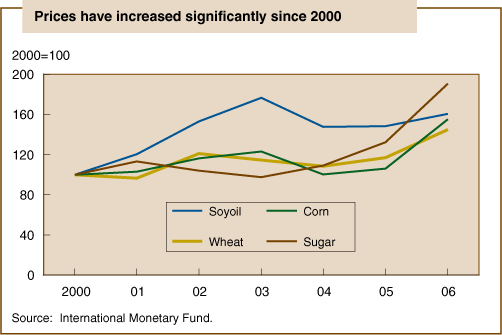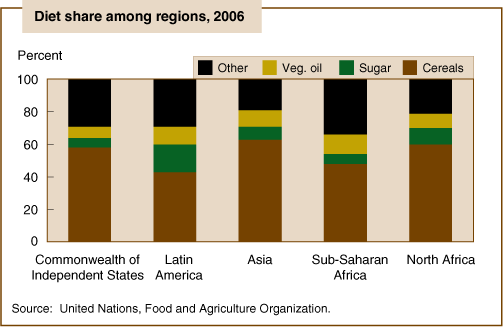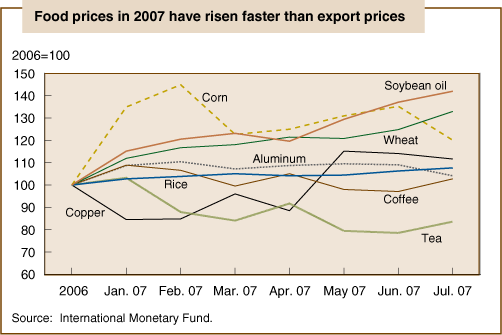Rising Food Prices Intensify Food Insecurity in Developing Countries
- by Stacey Rosen and Shahla Shapouri
- 2/1/2008
Highlights
- The use of food crops for biofuels, coupled with greater food demand, has reversed the path of declining price trends for several commodities.
- For highly import-dependent or highly food-insecure countries, any decline in import capacity stemming from rising food prices can have challenging food security implications.
- Food aid, a key safety net source, has stagnated during the last two decades, and its share has declined relative to total food imports of low-income countries.
Recent hikes in oil prices have raised serious concerns in low-income countries, both because of the financial burden of the higher energy import bill and potential constraints on imports of necessities like food and raw materials. Higher oil prices also have sparked energy security concerns worldwide, increasing the demand for biofuel production. The use of feed crops for biofuels, coupled with greater food demand spurred by high income growth in populous countries, such as China and India, has reversed the long-term path of declining price trends for several commodities.
Worldwide agricultural commodity price increases were significant during 2004-06: corn prices rose 54 percent; wheat, 34 percent; soybean oil, 71 percent; and sugar, 75 percent. But this trend accelerated in 2007, due to continued demand for biofuels and drought in major producing countries. Wheat prices have risen more than 35 percent since the 2006 harvest, while corn prices have increased nearly 28 percent. The price of soybean oil has been particularly volatile, due to high demand growth in China, the U.S., and the European Union (EU), as well as lower global stocks.
The Food and Agriculture Organization of the United Nations (FAO) estimated that the high food prices of 2006 increased the food import bill of developing countries by 10 percent over 2005 levels. For 2007, the food import bill for these countries increased at a much higher rate, an estimated 25 percent.
Price Rises Will Have Greatest Impact on Import-Dependent Countries
The 2006 ERS Food Security Assessment report for developing countries projected a slight increase in food availability during the next decade, mainly because of improvements in Asia. This increased availability is projected to lead to a 5-percent drop in the number of food insecure people in the 70 low-income countries included in the ERS analysis. But, with the recent surge in food prices, prospects are not so bright for many of the lowest income countries. Projections of food availability consider both domestic production and food imports. Changes in import capacity have direct implications on the food security of low-income countries where food import dependency has increased because of greater demand stemming from income and population growth, as well as slow gains in domestic production. For highly import-dependent or highly food-insecure countries, any decline in import capacity stemming from rising food prices can have challenging food security implications.
Food Price Hikes in 2006 Offset by Record Crops and Higher Export Revenues
In 2006, higher food and oil prices resulted in an estimated decline in total commercial imports by the 70 developing countries. However, most of the expected impact of higher oil and food prices on food security was offset by favorable weather leading to record or above-average crop production, as well as higher export earnings of some of the low-income countries. Higher prices for copper and aluminum brought significant financial gains to some of the poorest countries, such as Zambia, Tajikistan, Guinea, and Mozambique. Increased construction in China, which accounted for 50 percent of the growth in consumption for copper and aluminum metals, prompted the rise in metal prices, according to an International Monetary Fund (IMF) report.
Strong demand growth for labor in industrial countries and emerging markets also helped offset the impact of food and fuel import price increases in several countries. In Central America, remittances (transfers of money from foreign workers to their home countries) grew to account for 10-20 percent of Gross Domestic Product (GDP) in 2005, supporting growth in consumption. Asia is the largest recipient of remittances, accounting for 45 percent of the world total; IMF estimates that remittances contributed to about 10 percent of GDP in the Philippines and Nepal. Sri Lanka benefited from the economic boom in oil-exporting countries because more than 80 percent of its migrant workers were working in the oil-exporting Gulf States.
But will export prices for less developed countries continue to grow in the medium term, preventing an erosion in terms of trade for low-income countries? The 2006 IMF Outlook report argues that prices of metals will decline because the reserves of metals are more plentiful than oil reserves. The price trend for agricultural raw materials is less predictable because weather-related shocks will continue to create annual price volatility.
Grains and Oilseeds Crucial in Developing Country Diets
Price increases for grains and oilseeds are of particular concern to low-income countries as these commodities constitute a large share of their citizens’ diets. Low-cost grains historically have been a dietary staple in the poorest countries. In low-income Asian countries, grains account for an average of 63 percent of the diet; in North Africa and Commonwealth of Independent States (CIS—11 former Soviet republics), about 60 percent. In Sub-Saharan Africa, the region most vulnerable to food insecurity, grains account for nearly half of the calories consumed. The share of grains in the diet is lowest—about 43 percent—in lower income Latin America. In all regions, the situation varies by country. For example, in Bangladesh, the share is 80 percent, while in Eritrea and Ethiopia, both among the most food-insecure countries in the world, the share is around 70 percent.
The vegetable oil share of diets in low-income countries has risen as higher incomes made processed foods more accessible. For example, in Sub-Saharan Africa, the share of vegetable oil increased from less than 8 percent of the diet in 1980 to 12 percent in more recent years. In lower income Asian and Latin American countries, the share is now roughly 10 percent, up from 5-7 percent in 1980.
Dependence on Imports Rises in Many Developing Countries
Food import dependence in many developing countries has grown during the last three decades, leading to improved and more diversified diets. This trend can be attributed to higher incomes, slow growth in domestic food production, and trade liberalization. For lower income, highly import-dependent countries, however, higher food prices and a larger import bill can be a challenge, particularly for countries with limited foreign exchange availability and high vulnerability to food insecurity.
To identify countries that are highly sensitive to increases in grain prices, ERS ranked the 70 low-income countries by grain import dependence and daily calorie consumption. Six of the low-income countries (Eritrea, Liberia, Haiti, Georgia, Burundi, and Zimbabwe) depend on grain imports for more than 40 percent of their diets and consume an average of less than 2,200 calories per day. Eritrea, for example, is highly dependent on food imports: 87 percent of grains, 51 percent of vegetable oils, and 100 percent of sugar. Export earnings cover only 25 percent of Eritrea’s import bill; the remainder is filled by external assistance. Eritrea’s daily calorie availability of 1,465 in 2005 was among the lowest in the world. Therefore, higher prices and the possibility of a cut in imports could result in a food crisis in Eritrea.
In the world’s least developed countries (50 countries, as defined by the United Nations’ FAO, 32 of which are in Sub-Saharan Africa), the import share of production for wheat jumped from 93 percent in 1980 to more than 130 percent in 2005. For sugar, the share soared from only 4 percent in 1980 to more than 65 percent in 2005. A similar pattern is seen for vegetable oils, with the share rising from about 6 percent to 80 percent.
High Prices and Rising Import Dependence Lead to Widening Food Gaps
Using the ERS Food Security Assessment model, ERS researchers estimated the impact of higher 2007 prices on food security in the 70 low-income countries. The food gap (the amount of food needed to raise consumption of all income groups to the nutritional requirement of roughly 2,100 calories per person) by 2016 was first estimated under the assumption that food prices would rise 1 percent annually from 2007 to 2016. This baseline scenario results in a projected food gap of 25.2 million tons by 2016.
ERS then estimated the food gap under a price shock scenario, which assumed a nearly 28-percent increase in grain prices for 2007, (based on actual price movements through July 2007), followed by increases of 1 percent per year through 2016, as projected in the 2007 USDA baseline. In this scenario, the food gap increases 8 percent from the baseline scenario to 27.2 million tons. This result may overstate the price impact because no allowance is made for commensurate increases in export earnings, but recent trends suggest that prices for commodities exported by these countries are not growing as fast as grain or vegetable oil prices.
Responses to the 2007 price shock vary considerably by region and country. Estimated food gaps increase the most in Latin America and the Caribbean—24 percent—compared with less than 9 percent in Asia and 6 percent in Sub-Saharan Africa. Food gaps in Guatemala, Honduras, and Peru are projected to jump more than 20 percent by 2016. Peru has always relied heavily on imports of grain, and grain imports in both Guatemala and Honduras have risen 10 percent per year since 1990. In fact, in 2006, grain imports exceeded domestic production in Honduras by 30 percent, and Guatemala by 55 percent.
In Sub-Saharan Africa, countries most susceptible to economic shocks are often those suffering from political instability, which stifles domestic production. The price shock is projected to have the greatest impact in Cote d’Ivoire, where the food gap jumps an estimated 58 percent by 2016. This country has been experiencing political problems during the last decade, with grain production virtually stagnant between 1990 and the early 2000s. To maintain grain supplies for a growing population, grain imports rose, and have been virtually equal to production for the past 5 years or so. The 28-percent price shock is projected to significantly weaken the country’s commercial import capacity, worsening food security.
Zimbabwe’s grain output has fallen by nearly half since 2000 due to a government-imposed land redistribution program. To compensate for the shortfall, imports have grown and, just as in Cote d’Ivoire, import dependence has risen. The price shock is projected to result in a 38-percent increase in Zimbabwe’s food gap.
Rising Prices Raise the Cost of Food Aid
Low-income countries, in general, do not have domestic safety net programs to deal with economic shocks and therefore often rely on external assistance for support. However, in many cases, this assistance is not sufficient to compensate for production shortfalls brought about by higher import costs. For oil-importing developing countries, the $137-billion increase in the energy import bill in 2005 far exceeded the $84 billion of official development assistance they received. Food aid is often critical in mitigating the impact of strict financial constraints and reducing food availability in low-income countries. However, the volume of food aid worldwide has stagnated during the last two decades, and its share has declined relative to both total agricultural exports from food aid suppliers and total food imports of low-income countries. During 1990-2005, food aid received by the 70 low-income countries declined by 2 percent (in volume) annually.
In 2002-05, food aid accounted for about 9 percent of grain imports for the 70 low-income countries. The highest share—17 percent—was in Sub-Saharan Africa, and the share was 10 percent in lower income Asian countries, 6 percent in the CIS, and 3 percent in the low-income Latin American countries. Some low-income countries—like Ethiopia, Sierra Leone, Malawi, and Niger—are so poor that they were financially unable to import grain even under historically lower prices and relied heavily on food aid to augment their food supplies. But food aid quantities fall as prices rise, since the U.S., the major donor of food aid, sets an annual budget for food aid allocations. For many recipient countries, reductions in food aid are more of a problem than higher prices for food imports.
| Region | Base | Price shock | Percentage change |
|---|---|---|---|
| Asia | 3.62 | 3.94 | 8.67 |
| Latin America and Caribbean | 1.42 | 1.76 | 23.67 |
| Sub-Saharan Africa | 20.15 | 21.36 | 6.01 |
| Total 70 countries | 25.24 | 27.22 | 7.84 |
| Source: USDA, Economic Research Service. | |||
Between 2004 and 2006, global food aid donations averaged around 7.5 million tons per year. This amount was equal to nearly a third of the food gap estimated by ERS. Assuming that average grain prices increased nearly 28 percent in 2007, followed by increases of approximately 1 percent per year, as projected in the 2007 USDA baseline, the quantity of global food aid—given a constant 2006 budget—would fall to under 5 million tons by 2016. This amount of food aid would cover only 17 percent of the projected distribution gap in that year. Global food aid donations covered 25 percent of the gap in 2006. To maintain the 2006 level of food aid (8 million tons), the global food aid budget would need to rise about 35 percent over the next decade.
Is There a Silver Lining?
The ERS food security projections are based on several strict assumptions of commodity price trends. But the long-term food security impact of commodity price trends is uncertain because of differences in commodity composition among donor and recipient countries and varying price prospects for exports versus imports. In the long term, high food prices could boost domestic production in developing countries and improve food security. However, net results depend on the magnitude of supply response to the price increases and supporting economic policies, including technology adoption.
While rising energy prices have tightened the budgets of importing countries, they have also encouraged advances in biofuel technology, which could help fill the growing energy needs of developing countries. Investment in biofuel production by low-income countries could promote rural development, since large shares of their populations depend on agriculture for employment and livelihood. Countries such as Colombia and India have adopted production targets for increasing the share of biofuels in their transportation fuel supplies. Other countries are examining alternative biofuel sources appropriate for their particular environment and resource availability. Researchers in Asia, Latin America, and Africa have pointed toward the potential of several indigenous plants, such as jatropha, which grows wild and requires little water or nutrients, and has a relatively high oil yield. Agricultural research in low-income countries has been marginalized by national governments, as well as international development institutions such as the World Bank. However, the interest in biofuels could reverse this trend.
Currently, traditional biofuels such as wood account for about a third of all energy consumed in developing countries. These fuel sources are inefficiently used, however. For example, a kilogram of wood generates only about one-tenth of the heat of a kilogram of liquid petroleum gas. The new sources of biofuels could improve energy efficiency, increase the supply of energy, and boost farm incomes and rural employment where poverty is pervasive.
Success, however, depends on increased investment in new technology consistent with the agricultural sectors of low-income countries. Most low-income countries have poor market infrastructure and weak financial systems. This raises costs of production, particularly for newly introduced biofuel commodities that require dedicated production and distribution facilities. Finally, the financial capacity for investment in low-income countries is limited, so increased investment in biofuel production could distract from food production, thereby intensifying food insecurity.
This article is drawn from:
- Energy Price Implications for Food Security in Developing Countries. (2006). USDA, Economic Research Service.
You may also like:
- International Food Security. (n.d.). U.S. Department of Agriculture, Economic Research Service.
- The Future of Biofuels: A Global Perspective. (2007). Economic Research Service. in Amber Waves, Vol. 5, Issue 5..
We’d welcome your feedback!
Would you be willing to answer a few quick questions about your experience?




